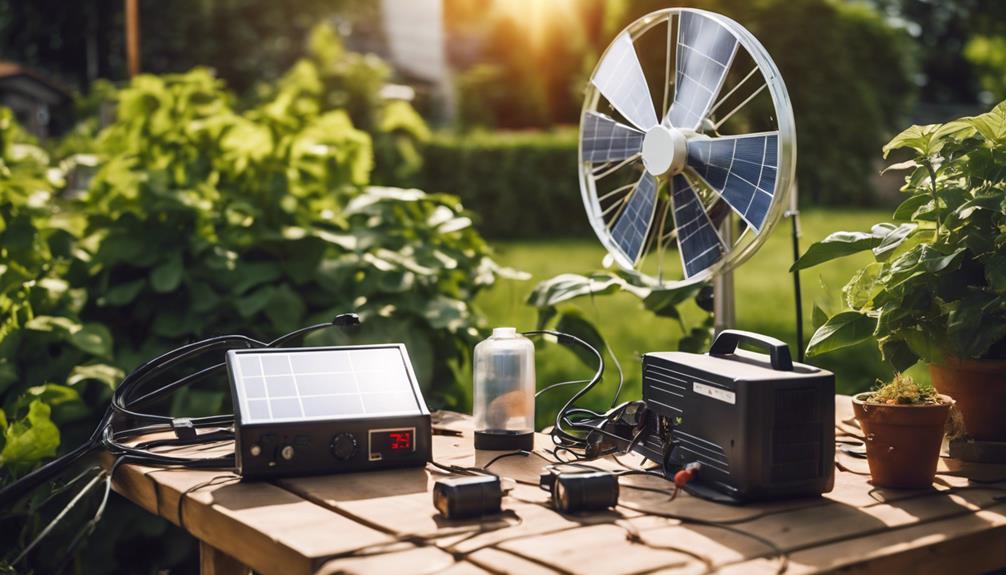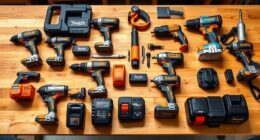You can take control of your energy future and generate your own electricity with DIY power sources. By harnessing solar, wind, or even water energy, you'll reduce your reliance on the grid and save on utility bills. For example, constructing a wind turbine can be both affordable and effective. You'll also discover how combining different sources improves efficiency and reliability. Plus, government incentives can make these projects even more financially attractive. If you're curious about specific steps to get started or further strategies, there's much more to explore on this journey toward energy independence.
Key Takeaways
- DIY power sources, like solar and wind energy, reduce reliance on the electrical grid and enhance energy independence.
- Combining multiple renewable energy sources can increase efficiency and reliability, providing a consistent energy supply year-round.
- DIY projects are cost-effective, often saving 25% to 50% on energy costs compared to commercial options.
- Government incentives can significantly lower installation costs, covering up to 30% of renewable energy project expenses.
Importance of DIY Power Sources
DIY power sources are essential because they empower you to reduce reliance on the electrical grid, enhancing your energy independence and resilience against outages. By generating your own electricity, you not only save on utility bills but also gain control over your energy supply. DIY power sources such as solar panels and wind turbines allow you to harness renewable energy from the sun and wind, reducing your carbon footprint and contributing to a cleaner environment. With the ability to generate your own electricity, you can also consider incorporating systems to meet your daily water needs, further increasing your self-sufficiency and reducing reliance on external resources.
Investing in renewable energy, particularly solar energy, offers a sustainable solution to meet your power needs while minimizing your carbon footprint. When you harness the sun's energy, you can considerably cut your long-term costs. Many homeowners enjoy a payback period of 5-10 years for solar panel installations, making it a financially viable option. Plus, government incentives and rebates can alleviate initial costs, sometimes covering up to 30% of your investment in renewable energy projects.
Engaging in DIY power generation fosters a sense of self-sufficiency, encouraging you to develop new skills and connect with your community. As you embrace these sustainable living practices, you contribute to environmental sustainability and combat climate change. By prioritizing DIY power sources, you're not just improving your financial situation; you're also making a positive impact on the planet for future generations.
Overview of Energy Generation Methods

When considering energy generation methods, you'll find a variety of options that cater to different needs and resources available.
Solar power is one of the most popular choices, using photovoltaic cells in solar panels to convert sunlight into electricity. Depending on the panel type, efficiency typically ranges from 7% to 20%, requiring at least four hours of sunlight daily for ideal performance.
Wind power is another effective method, utilizing wind turbines to harness kinetic energy. For effective operation, these turbines need an average wind speed of at least 14 mph, with their efficiency influenced by height and placement.
If you have access to flowing water, micro-hydro systems can generate electricity based on water flow rate and elevation differences.
Biomass and biogas systems are excellent for waste-rich environments, converting organic waste into energy through combustion or producing methane gas via anaerobic digestion, respectively.
Finally, geothermal energy taps into the Earth's internal heat, providing a steady and sustainable energy source, especially in volcanic regions.
Each of these alternative energy methods allows you to generate electricity while contributing to a greener future.
Step-by-Step Wind Turbine Construction

Building your own wind turbine can be a rewarding project, allowing you to harness wind energy for electricity generation while applying the knowledge of various energy generation methods.
Here's a step-by-step guide to help you construct your own wind turbine and generate power effectively:
- Select a Generator: Choose a surplus permanent magnet DC motor. This is essential for converting wind energy into electrical energy efficiently.
- Create the Blades: Use the PVC pipe method. Cut the PVC into specific lengths and shape them for maximum aerodynamics to guarantee best performance.
- Build a Stable Mounting: Use durable materials like plywood and pipe fittings. Make certain your turbine's base is sturdy, and protect wooden parts with white latex paint to withstand the elements.
- Construct the Tower: Aim for a height of at least 30 feet to capture wind flow efficiently. Be sure to check local zoning regulations regarding turbine height.
Once assembled, test your wind turbine in windy conditions. This allows you to observe blade performance and make adjustments, making sure your new energy source generates electricity effectively!
Cost Analysis of DIY Projects

When you're considering DIY power sources, budget planning is essential for materials and tools.
You'll also want to analyze potential long-term savings against initial costs to make informed decisions.
Budgeting for Materials
Budgeting for materials in DIY projects is essential, as it can greatly impact your overall costs and savings compared to commercial alternatives. When planning your DIY energy sources, consider the costs of components and how you can minimize expenses.
Here are four budgeting tips to help you get started:
- Research Local Costs: Investigate prices for solar panels and DIY wind turbine components in your area. This can save you from unexpected expenses.
- Look for Discounts: Engage with local homesteading communities. They often have insights or can offer discounts on materials.
- Utilize Government Incentives: Explore available tax credits and rebates. These can substantially lower your upfront costs and make renewable energy projects more accessible.
- Plan for Future Needs: Consider the scale of your project. Investing in higher-capacity components might seem more expensive initially but can provide long-term savings.
Long-term Savings Analysis
Investing in DIY power sources not only lowers your initial costs compared to commercial options but also leads to significant long-term savings on your energy bills. For instance, you can build a DIY wind turbine for as low as $140.62, while commercial alternatives can set you back between $3,000 and $10,000. This drastic difference means you'll start seeing returns on your investment sooner.
When you generate your own electricity with solar panels or wind turbines, you can save anywhere from 25% to 50% on your monthly energy costs, especially if you live in sunny areas and take advantage of government incentives. Typically, homeowners enjoy a payback period of just 5 to 10 years, making this investment worthwhile.
Moreover, if you combine multiple energy sources, like wind and solar, you can optimize energy generation and enhance reliability, leading to even greater long-term savings. Just remember, regular maintenance is key to keeping your systems efficient; neglecting this can diminish your energy output and increase costs.
Comparative Cost Assessment
Understanding the comparative costs of DIY energy projects reveals the notable financial advantages they offer over commercial options.
When you consider the investment for generating electricity at home, DIY solutions can save you a considerable amount. Here's a quick breakdown:
- DIY Wind Turbine: You can build one for about $140.62, compared to commercial models that can cost between $2,000 and $10,000.
- Solar Panels: While installations typically range from $3,000 to $4,000 per kilowatt, your DIY approach can lower these costs remarkably.
- Biomass and Biogas Systems: Averaging around $3,000 to $5,000 per kilowatt, these systems are viable for those with organic waste, especially if you tackle the installation yourself.
- Backup Generators: Diesel or biodiesel setups can cost $3,000 to $10,000, but a DIY option can reduce your expenses.
Combining Renewable Energy Sources

When you combine renewable energy sources like solar and wind, you reveal significant benefits that boost your energy production.
This hybrid system not only enhances efficiency but also guarantees a reliable power supply by making the most of varying weather conditions.
Effective resource integration can lead to greater overall energy generation, making your DIY power project even more successful.
Benefits of Hybrid Systems
Combining renewable energy sources like solar and wind can greatly boost your home's energy efficiency and reliability throughout the year. By harnessing different natural resources, you can optimize your power generation and reduce your reliance on your electric company.
Here are some key benefits of hybrid systems:
- Increased Energy Production: Hybrid systems can generate up to 30% more energy compared to using a single source. When wind speed is high, your turbines can work well, while solar panels can still capture sunlight on clear days.
- Weather Resilience: Solar power often shines during summer months, while wind energy can be more effective during winter. This seasonal balance guarantees you have a consistent energy supply year-round.
- Better Energy Storage: With excess energy generated, you can store it for later use. This helps manage energy needs during low production periods and reduces dependence on the grid.
- Cost Savings: A hybrid system can lead to significant savings on your energy bills, with a payback period of 5-7 years, depending on local incentives and energy prices.
Switching to a hybrid system is a smart move for energy independence!
Effective Resource Integration
Effectively integrating solar and wind energy can greatly enhance your renewable power generation, guaranteeing a steady energy supply regardless of weather conditions. Combining these two sources works best because solar panels thrive on sunny days while wind turbines can generate power during overcast or stormy conditions. This synergy allows you to harness energy more consistently.
When setting up your hybrid system, you'll need to take into account the amount of space you have available. Solar panels require ample sunlight, while wind turbines need open areas for peak wind flow. Make sure to position both in locations where they can perform efficiently.
Utilizing a battery bank is essential in this setup. It stores excess energy generated during peak production times, allowing you to access power at night or during calm weather. Monitoring your system with a charge controller helps prevent issues like battery overcharging and guarantees you're maximizing energy output.
Practical Tips for Sustainable Living

Implementing simple practices like rainwater harvesting and composting can dramatically enhance your sustainable living efforts while saving you money. Here are four practical tips to get you started:
- Rainwater Harvesting: Install a rainwater collection system to capture runoff from your roof. You could save significant amounts on your water bill by collecting up to 1,300 gallons of water from just one inch of rainfall.
- Composting: Start composting your food scraps and yard waste. This can divert up to 30% of your household waste from landfills, enriching your garden soil while reducing the need for chemical fertilizers.
- Energy-Efficient Appliances: Upgrade to energy-efficient appliances. By using these, you can reduce your household energy consumption by 15-30%, leading to lower electricity bills.
- Community Solar Garden: If your roof space isn't suitable for solar panels, consider joining a community solar garden. This will allow you to invest in renewable energy, providing savings on your utility bills.
Conclusion
Incorporating DIY power sources into your life isn't just a dream; it's entirely achievable.
You might worry about the initial costs, but think about the long-term savings and environmental benefits.
By embracing renewable energy, you're not just cutting down on your bills; you're also contributing to a sustainable future.
So, roll up your sleeves, start experimenting, and enjoy the empowerment that comes from generating your own electricity.
Your journey toward energy independence starts today!










